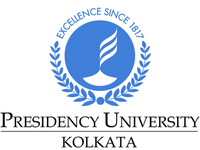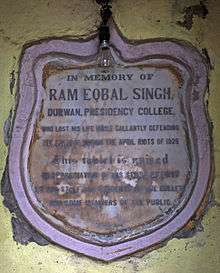Presidency University, Kolkata
 | |
| Motto | Excellence since 1817 |
|---|---|
| Type | Public |
| Established | 20 January 1817 |
| Founders |
Raja Rammohan Roy David Hare Sir Edward Hyde East Radhakanta Deb Baidyanath Mukhopadhya Rasamay Dutt |
| Chancellor |
Keshari Nath Tripathi Governor of West Bengal |
| Vice-Chancellor | Anuradha Lohia |
| Students | 2,198[1] |
| Undergraduates | 1,462[1] |
| Postgraduates | 736[1] |
| Location | Kolkata, West Bengal, India |
| Campus | Urban |
| Affiliations | UGC, NAAC, AIU |
| Website |
presiuniv |
Presidency University, Kolkata, formerly Hindu College and Presidency College,[2] is a public state university located in Kolkata, West Bengal.[3]
The college was established in 1817 by Raja Ram Mohan Roy, Radhakanta Deb, David Hare, Justice Sir Edward Hyde East, Baidyanath Mukhopadhya and Rasamay Dutt.
After a few years of establishment, in 1855, the Pathshala wing of Hindu College was renamed as Hindu School and the Mahapathshala wing was renamed as Presidency College, i.e., the college of the Bengal Presidency. In 2010, under West Bengal's Chief Minister, Buddhadeb Bhattacharya, who was a former student of the college, it was upgraded to the status of a full university by the Presidency University Act, 2010, passed in the West Bengal Legislative Assembly.
The longest serving Principal of Presidency College was J. Sutcliff, who was its principal intermittently for 20 years, from 1852-1875. This university is one of the finest academic institutions in India and boasts of an exceptional pool of notable alumni spread across the world.
History
Origin

With the creation of the Supreme Court of Calcutta in 1773 many Hindus of Bengal showed eagerness to learn the English language. David Hare, in collaboration with Raja Radhakanta Deb had already taken steps to introduce English education in Bengal. Babu Buddinath Mukherjee advanced the introduction of English as a medium of instruction further by enlisting the support of Sir Edward Hyde East, Chief Justice of the Supreme Court of India who called a meeting of 'European and Hindu Gentlemen' in his house in May 1816. The purpose of the meeting was to "discuss the proposal to establish an institution for giving a liberal education to the children of the members of the Hindu Community". The proposal was received with unanimous approbation and a donation of over Rs. 100, 000 was promised for the setting up of the new college. Raja Ram Mohan Roy showed full sympathy for the scheme but chose not to come out in support of the proposal publicly for fear of "alarming the prejudices of his orthodox countrymen and thus marring the whole idea".
The College was formally opened on Monday, 20 January 1817 with 20 'scholars'. The foundation committee of the college, which oversaw its establishment, was headed by Raja Rammohan Roy. The control of the institution was vested in a body of two Governors and four Directors. The first Governors of the college were Maharaja Tejchandra Bahadur of Burdwan and Babu Gopee Mohan Thakoor. The first Directors were Babu Gopi Mohun Deb of Sobhabazar, Babu Joykissen Sinha, Babu Radha Madhab Banerjee and Babu Gunganarain Doss. Babu Buddinath Mukherjee was appointed as the first Secretary of the college. The newly established college mostly admitted Hindu students from affluent and progressive families, but also admitted non-Hindu students such as Muslims, Jews, Christians and Buddhists.
At first the classes were held in a house belonging to Gorachand Bysack of Garanhatta (later renamed 304, Chitpore Road), which was rented by the college. In January 1818 the college moved to 'Feringhi Kamal Bose's house' which was located nearby in Chitpore.[4] From Chitpore, the college moved to Bowbazar and later to the building that now houses the Sanskrit College on College Street.
University

In 1972, an unsigned article was released by the faculty members of the college demanding that the college be given full university status. It is an open secret that the author of the article was Prof. Dipak Banerjee, the legendary economics professor of the college. The state government, then under the chief ministership of Siddhartha Shankar Ray, showed the willingness to listen to the demands of the faculty members, but it was still too early to grant full autonomy to the college. In 2007, the state government, under the chief ministership of Buddhadeb Bhattacharya and Higher Education ministership of Sudarshan Raychaudhuri, appointed a seven-member committee, under the leadership of Justice Chittotosh Mookerjee. The other members of the committee included Prof. Ashes Prasad Mitra, Prof. Barun De, Dr. Bimal Jalan and Prof. Subimal Sen, to look into the possibility of upgrading the status of the college. The report of the committee suggested that the state government, while granting the college partial autonomy, should create more professorships and scholarships for meritorious students, thus making it possible for the grant of full autonomy to the college in future.
In 2009, the Governing Body of the college unanimously adopted the proposal that the college should be given full university status. On 16 December 2009, the Government of West Bengal tabled a bill in Bidhansabha titled the Presidency University Act, 2009, in which the West Bengal Legislative Assembly granted full university status to the college. The bill stated that once the college becomes a full state-aided university it will be renamed Presidency University.
The new logo of the Presidency University has been created by Sabyasachi Dutta (সব্যসাচী দত্ত) as reported in a letter to the Editor of Anandabazar Patrika on 1 April 2013.
On 19 March 2010, the West Bengal Government passed the Presidency University Bill, 2009 in the State Legislative Assembly.[3] On 7 July 2010, the governor of West Bengal, M K Narayanan gave his assent to the Presidency University Bill.[5] On 23 July 2010, the Government of West Bengal published the gazette notification completing all the legal formalities for Presidency to become a full university.[6] Prof. Amiya Bagchi was given the responsibility of chairing a committee set up to select and appoint the first vice chancellor of the university. Prof. Amita Chatterjee, a retired professor of philosophy at Jadavpur University, was appointed as the first vice-chancellor of Presidency University on 5 October 2010.[7]
In 2011, Higher Education Minister Bratya Basu suggested that a mentor group, along the lines of the Nalanda mentor group, would be formed to oversee the work of the university. At the beginning of June 2011, the chief minister of West Bengal, Km. Mamata Banerjee, announced that a committee would be formed with Prof. Amartya Sen as its chief mentor and Harvard-based Prof. Sugata Bose as its chairman to oversee the running of the college and perform the task of appointing all its officials and faculty members. The Presidency mentor group [8] also includes as its members Prof. Abhijit Banerjee, Prof. Ashoke Sen, Prof. Sabyasachi Bhattacharya, Prof. Nayanjot Lahiri, Prof. Himadri Pakrashi, Prof. Rahul Mukerjee and Dr. Isher Judge Ahluwalia, Prof. Swapan Kumar Chakravorty. Prof. Sukanta Chaudhuri resigned from the committee in 2012.[9]
In October 2011, Professor Malabika Sarkar, formerly Professor of English at Jadavpur University, was appointed Vice-Chancellor of Presidency University. During her term as Vice-Chancellor more than 150 faculty members - Presidency University's first faculty - were recruited and joined. Presidency's first officers and the first set of non-teaching staff were also recruited. A new logo was created by an alumnus, infrastructural projects were initiated and the Presidency University Vice-Chancellor's Fund for Excellence was set up. In December 2012, UGC recognized Presidency as an Institution of National Eminence. MOUs for international collaboration with Trinity College, Dublin, Groningen University, Netherlands, and D'Etudes Politiques de Paris (Sciences Po, Paris) were signed. Presidency University's First Convocation was held on 22 August 2013 and the Foundation Stone for Presidency's Second Campus at Rajarhat was unveiled by Chief Minister Mamata Banerjee on 6 February 2014. Presidency's First Statutes were completed. Professor Sarkar's tenure as Vice-Chancellor ended in May 2014.
After Professor Sarkar's time-period expired, a new search committee was built by the state govt. and Chancellor of West Bengal. The search committee published a list of 3 Professors and sent to the Chancellor. The first person in the list Prof. Sabyasachi Bhattacharya refused to join administration and choose to teach at Presidency as the Acharya Jagadish Chandra Bose Distinguished Chair Professor in the Department of Physics. Ultimately the position went to Professor Anuradha Lohia, a past graduate of Presidency College, who was a senior professor at Bose Institute, a premier institution of research and scholarship in Kolkata. Professor Lohia had taught a number of students for their PhD research over many years in Bose Institute, affiliated for its PhD degree with the Calcutta University.
Campus
The campus of the university was gradually developed through the last quarter of the nineteenth and first quarter of the twentieth centuries. The main building was built in 1875. The clock tower on top of the main building was built towards the end of the nineteenth century. The building in which the science departments, including the Baker Laboratory,the Physics Lecture Theatre and the Biological sciences department are located, was built in 1913. Until 1956, the college's centenary year, the main playing field was accompanied by lawn tennis courts. Later space was made for the construction of a new building which now houses some social science departments and the Derozio Hall, which is the auditorium of the university. In the late 1980s and early 1990s one smaller building was built in one corner of the grounds to make space for more departmental work. After the upgrading of the college to the status of a university, the university administration built a new library wing, in one corner of the premises, behind the playing field.
Across Peary Charan Sarkar Street, a side road which separates the university from the Calcutta University, stands the Eden Hindu Hostel, which was built in the early twentieth century.
The entrance of the campus is marked with a small guard house on the left. On the wall of the guard room is a plaque dedicated to durwan (guard) Ram Eqbal Singh, who died defending the institute from the rioters.[10]
Administration
The college was formerly administered by a principal, a bursar, a deputy controller of examinations and the respective heads of departments. The university is now administered by the Vice-Chancellor, the Registrar, the Dean of Students' affairs, the Controller of Examinations and the respective heads of the departments.
Notable alumni
| List of University Principals | ||||
|---|---|---|---|---|
|
References
- 1 2 3 CU information brochure for MSc, BTech Retrieved 25 November 2011
- ↑ Chakraborty, Rachana (2012). "Presidency College". In Islam, Sirajul; Jamal, Ahmed A. Banglapedia: National Encyclopedia of Bangladesh (Second ed.). Asiatic Society of Bangladesh.
- 1 2 Our Bureau (2010-03-20). "The Telegraph - Calcutta (Kolkata) | Frontpage | CM beats Mamata to Presidency". Telegraphindia.com. Retrieved 2012-08-01.
- ↑ This building is a historic one because Raja Ram Mohan Roy inaugurated his Brahma Sabha there and Reverend Alexander Duff of the Scottish Missionary Board started his educational establishment, the General Assembly's Institution there as well a few years later in 1830.
- ↑ Presidency varsity bill gets governor's assent
- ↑ Express News Service (2010-07-24). "Presidency University legal steps complete". Express India. Retrieved 2012-08-01.
- ↑ "The Telegraph - Calcutta (Kolkata) | Frontpage | Comfort factor confines Presidency to home pool". Telegraphindia.com. 2010-10-06. Retrieved 2012-08-01.
- ↑ "Presidency Mentor Group". Retrieved 2013-11-26.
- ↑ "Sukanta Chaudhuri quits". Retrieved 2013-11-26.
- ↑ Our Bureau (2013-04-14). "Presi guard-ian angel". The Telegraph, Calcutta. Retrieved 6 May 2014.
External links
| Wikimedia Commons has media related to Presidency University, Kolkata. |
Coordinates: 22°34′35″N 88°21′44″E / 22.57639°N 88.36222°E